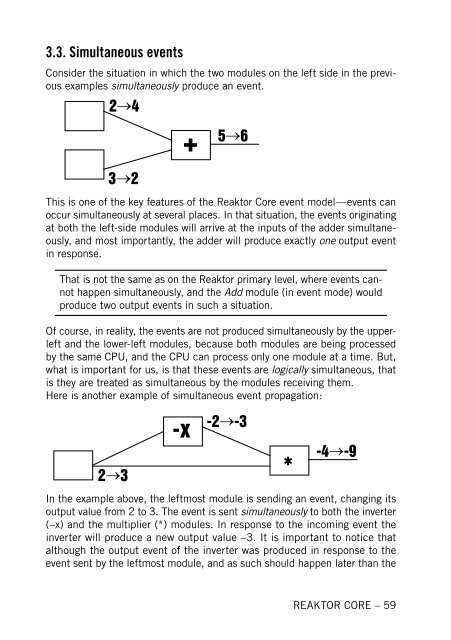1. First steps in Reaktor Core - Native Instruments
1. First steps in Reaktor Core - Native Instruments
1. First steps in Reaktor Core - Native Instruments
You also want an ePaper? Increase the reach of your titles
YUMPU automatically turns print PDFs into web optimized ePapers that Google loves.
3.3. Simultaneous events<br />
Consider the situation <strong>in</strong> which the two modules on the left side <strong>in</strong> the previous<br />
examples simultaneously produce an event.<br />
�<br />
����<br />
����<br />
��<br />
����<br />
This is one of the key features of the <strong>Reaktor</strong> <strong>Core</strong> event model—events can<br />
occur simultaneously at several places. In that situation, the events orig<strong>in</strong>at<strong>in</strong>g<br />
at both the left-side modules will arrive at the <strong>in</strong>puts of the adder simultaneously,<br />
and most importantly, the adder will produce exactly one output event<br />
<strong>in</strong> response.<br />
That is not the same as on the <strong>Reaktor</strong> primary level, where events cannot<br />
happen simultaneously, and the Add module (<strong>in</strong> event mode) would<br />
produce two output events <strong>in</strong> such a situation.<br />
Of course, <strong>in</strong> reality, the events are not produced simultaneously by the upperleft<br />
and the lower-left modules, because both modules are be<strong>in</strong>g processed<br />
by the same CPU, and the CPU can process only one module at a time. But,<br />
what is important for us, is that these events are logically simultaneous, that<br />
is they are treated as simultaneous by the modules receiv<strong>in</strong>g them.<br />
Here is another example of simultaneous event propagation:<br />
�<br />
����<br />
���<br />
������<br />
��<br />
������<br />
In the example above, the leftmost module is send<strong>in</strong>g an event, chang<strong>in</strong>g its<br />
output value from 2 to 3. The event is sent simultaneously to both the <strong>in</strong>verter<br />
(–x) and the multiplier (*) modules. In response to the <strong>in</strong>com<strong>in</strong>g event the<br />
<strong>in</strong>verter will produce a new output value –3. It is important to notice that<br />
although the output event of the <strong>in</strong>verter was produced <strong>in</strong> response to the<br />
event sent by the leftmost module, and as such should happen later than the<br />
REAKTOR CORE – 59










